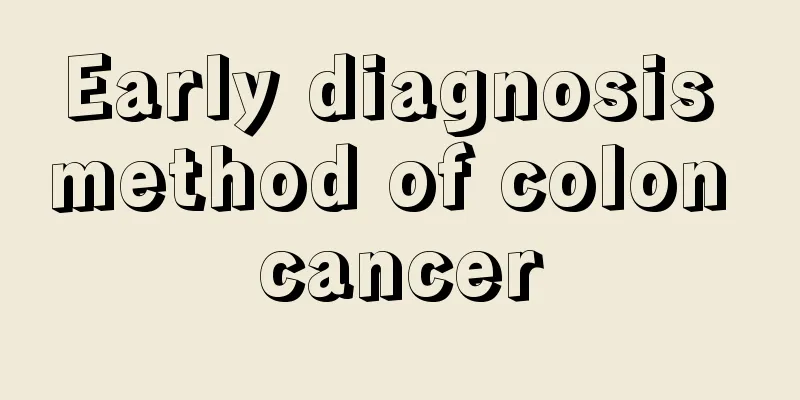Early diagnosis method of colon cancer

|
The large intestine includes the colon and rectum, with a total length of 1.2 to 2 meters, and is divided into the cecum, ascending colon, transverse colon, descending colon, sigmoid colon and rectum. With the improvement of people's living standards and changes in eating habits, the incidence of colorectal cancer has continued to rise, ranking fifth among malignant tumors, second only to gastric cancer, esophageal cancer, liver cancer and lung cancer, especially in large and medium-sized cities. Colorectal cancer is divided into two types: colon cancer and rectal cancer. Most patients with colon cancer are middle-aged or older, with an average age of 45 years old, and about 5% of patients are under 30 years old. Patients with colon cancer may have no symptoms in the early stages, but as the disease progresses, a series of cancer symptoms will appear. Clinically, the colon is divided into the left colon and the right colon based on the middle segment of the transverse colon. The manifestations vary depending on the location of the cancer. Right colon cancer: Because the intestinal cavity is large and the stool in the intestine is liquid, the cancer in this section of the intestine is mostly ulcer-type or cauliflower-shaped, and rarely has annular stenosis, so obstruction is not common. However, these cancers often rupture and bleed, secondary infection, and toxin absorption. Main clinical manifestations: 1. Abdominal discomfort or pain, often in the right lower abdomen, very similar to chronic appendicitis. If the tumor is located in the hepatic flexure and the stool is dry and hard, colic may also occur, and it should be distinguished from chronic cholecystitis. About 50% of patients have loss of appetite, fullness, belching, nausea and vomiting. 2. Changes in stool. In the early stage, the stool is thin, contains pus and blood, and the frequency of bowel movements increases. This is related to the formation of cancer ulcers. The amount of bleeding is small and difficult to see with the naked eye, but the occult blood test is often positive. When the tumor size increases, it affects the passage of stool and diarrhea and constipation may occur alternately. 3. Abdominal mass: This mass may be the cancer itself, or it may be a mass formed by extraintestinal infiltration and adhesion. 4. Anemia, emaciation or cachexia. Left-side colon cancer: Most are invasive, often causing annular stenosis, so the main clinical manifestations are acute and chronic intestinal obstruction. Clinical manifestations: 1. Abdominal colic is the main manifestation of cancer with acute intestinal obstruction, accompanied by abdominal distension, hyperperistalsis, constipation and gas obstruction. Chronic obstruction manifests as abdominal distension, paroxysmal abdominal pain, hyperactive bowel sounds, constipation, blood and mucus in stool. Partial intestinal obstruction sometimes lasts for several months before turning into complete intestinal obstruction. 2. Difficulty in defecation. Half of the patients have this symptom. As the disease progresses, constipation becomes more severe. If the tumor is located lower, there may also be difficulty in defecation and a feeling of tenesmus. 3. Blood and mucus in stool. As the stool in the left colon gradually takes shape, blood and mucus are not mixed with the stool. In about 25% of patients, blood and mucus can be seen in the stool by naked eye. The early symptoms of colon cancer are often mild or not obvious, and are often ignored by patients, so they are easily missed. Patients over middle age should be alert to the possibility of colon cancer if they have the following symptoms: ① Changes in bowel habits (such as constipation, diarrhea or difficulty in defecation), persistent abdominal discomfort, dull pain or bloating in the recent period; ②The stool becomes thinner or contains blood and mucus; ③The fecal occult blood test is continuously positive; ④ Unexplained anemia, fatigue or weight loss, etc.; ⑤ Abdominal lumps can be felt. When the above suspicious phenomena occur, in addition to further medical history inquiry and physical examination, X-ray barium enema or fiber colonoscopy should be performed immediately to rule out space-occupying lesions. |
<<: What are the diagnostic methods for colon cancer?
>>: What is the basis for diagnosing colon cancer
Recommend
What foods to eat for hemorrhoids
Hemorrhoids are a very common disease. Such a dis...
Are colon cancer and appendix cancer the same?
Colon cancer and cecal cancer are both types of c...
Can I exercise during cervical cancer?
Generally speaking, it is relatively rare for pat...
Does liver cancer tend to cluster in families? Two types of food are the triggers of liver cancer
According to statistics, 110,000 people die from ...
Three major characteristics of atrial fibrillation
Atrial fibrillation usually has several major cha...
Measures to control haze
The rapid development of industry in recent years...
Can drinking lemon water help sober you up
Many people have drunk lemon water. Lemon water h...
What is liver cancer grade Ⅰ
What is liver cancer grade 1? 1. Liver cancer is ...
Tinnitus, earache, headache, nasal congestion, is it nasopharyngeal cancer?
Are tinnitus, ear pain, headache, and nasal conge...
Matters related to fiberoptic laryngoscopy
In the past, people could only imagine such thing...
Esophageal cancer is related to long-term consumption of overheated food
Esophageal cancer refers to a malignant tumor of ...
Causes of nodular thyroid cysts
Nodular thyroid cyst is a very common disease. Th...
Five major hazards of staying up late that you must know
As the pace of modern life accelerates, more and ...
Can blood tests detect liver cancer? What are the methods for liver cancer testing?
Only if we can curb the disease in its early stag...
What are the reasons for frequent panic and fatigue?
In today's social life, symptoms such as palp...









